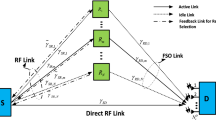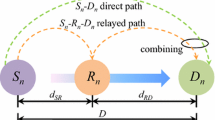Abstract
In this paper, end-to-end average bit error rate (ABER) of a multi-hop decode-and-forward relay system is evaluated using ultra-wideband transmitted reference (TR) receiver over a multi-path fading channel. Distribution of individual hop signal to noise ratio (SNR) is approximated by a log-normal distribution and corresponding ABER is evaluated by Gauss-Hermite Quadrature rule. These individual hop ABERs are then used to find the end-to-end ABER performance analytically which is faster than the simulation method available in the literatures. Performances of three variants of non-coherent TR receivers: simple transmitted reference, average transmitted reference and differential transmitted reference (DTR) receivers are compared assuming same total transmit power for a fixed end-to-end distance in line-of-sight (LOS) and non line-of-sight (NLOS) channel model. It is observed that the end-to-end ABER performance using DTR receivers is the best and multi-hop relaying is also most effective using these receivers to improve the performance. It is also found that the laws of diminishing returns hold for performance gain in average transmit SNR per bit at a particular ABER in LOS channel i.e. performance improvement in terms of transmit SNR is not equal as the number of hop increases. It decreases with increase in hop number but the reverse trend can be found in NLOS channel.






Similar content being viewed by others
References
Roy, S., Foerster, J. R., Somayazulu, V. S., & Leeper, D. G. (2004). Ultrawideband radio design: the promise of high-speed, short-range wireless connectivity. Proceedings of the IEEE, 92(2), 295–311.
Win, M. Z., & Scholtz, R. A. (1998). Impulse radio: How it works. IEEE Communications Letters, 2(2), 36–38.
Win, M. Z., & Scholtz, R. A. (2000). Ultra-wide bandwidth time-hopping spread-spectrum impulse radio for wireless multiple-access communications. IEEE Transactions on Communications, 48(4), 679–689.
Foerster, J., Green, E., Somayazulu, S., & Leeper, D. (2th Quarter 2001). Ultra-wideband technology for short or medium range wireless communications. Intel Technology Journal.
Zhang, H., Udagawa, T., Arita, T., & Nakagawa, M. (2002). Home entertainment network: Combination of IEEE 1394 and ultra wideband solutions. In Proceedings IEEE conference on ultra wideband systems and technologies, pp. 141–145.
Federal Communications Commission (FCC): First report and order in the matter of revision of part 15 of the commission’s rules regarding ultra-wideband transmission systems. Tech. Rep. ET Docket 98–153, FCC 02–48, 2002.
Cho, C., Zhang, H., & Nakagawa, M. (2004). A UWB repeater with a short relaying-delay for range extension. In Proceedings IEEE Wireless Communications and Networking Conference (WCNC), 2, 1154–1158.
Cho, C., Zhang, H., & Nakagawa, M. (2007). A short delay relay scheme using shared frequency repeater for UWB impulse radio. In Proceedings IEICE Transactions on Fundamentals of Electronics, Communications and Computer Sciences, E90-A (7), pp. 1444–1451.
Maichalernnukul, K., Kaiser, T., & Zheng, F. (2009). On the performance of coherent and noncoherent UWB detection systems using a relay with multiple antennas. IEEE Transactions on Wireless Communications, 8(7), 3407–3414.
Foerster, J., et al. (2002). Channel modeling sub-committee report final [R]. IEEE document: IEEE P802.15-02/490r1-SG3a, 12.
Win, M. Z., & Scholtz, R. A. (1998). On the energy capture of ultrawide bandwidth signals in dense multipath environments. IEEE Communications Letters, 2(9), 245–247.
Cassioli, D., Win, M. Z., Vatalaro, F., & Molisch, A. F. (2007). Low complexity rake receivers in ultra-wideband channels. IEEE ransactions on Wireless Communications, 6(4), 1265–1275.
Chao, Y.-L., & Scholtz, R. A. (2005). Ultra-wideband transmitted reference systems. IEEE Transactions on Vehicular Technology, 54(5), 1556–1569.
Hoctor, R., & Tomlinson, H. (2002). Delay-hopped transmitted-reference RF communications. In Proceedings IEEE UWBST, pp. 265–269.
Chao, Y.-L., & Scholtz, R. A. (2003). Optimal and suboptimal receivers for ultra-wideband transmitted reference systems. In Proceedings IEEE GLOBECOM, 2, 759–763.
Hasna, M. O., & Alouini, M. S. (2003). End-to-end outage probability of multihop transmission over lognormal shadowing channels. The Arabian Journal for Science and Engineering, 28(2C), 3544.
Simon, M. K., & Alouini, M. S. (2000). Digital communication over fading channels, 1st edn. London: Wiley.
Abramovitz, M., & Stegun, I. A. (1972). Handbook of mathematical functions with formulas, graphs, and mathematical tables. New York: Dover.
Morgado, E., Mora-Jimenez, I., Vinagre, J. J., Ramos, J., & Caamano, A. J. (2010). End-to-end average BER in multihop wireless networks over fading channels. IEEE Transactions on Wireless Communications, 9(8), 2478–2487.
Author information
Authors and Affiliations
Corresponding author
Evaluation of \(\mu _\gamma \) and \(\sigma _\gamma \)
Evaluation of \(\mu _\gamma \) and \(\sigma _\gamma \)
To evaluate the \(\mu _\gamma \) and \(\sigma _\gamma \) we need to first calculate the \(\mu _\alpha \) and \(\sigma _\alpha ^2\) the mean and variance of \(\ln \alpha \). Applying Wilkinson’s method to (13) which matches the first two moments of the sum of log-normals with that of approximated log-normal, the \(\mu _\alpha \) and \(\sigma _\alpha ^2\) can be found following [16].
where with \(L\) number of resolvable multi-paths \(u_1\) and \(u_2\) can be expressed as
Using the fact that the constant multiplied to a log-normal only shifts its mean of the associated Gaussian and keeps variance unchanged, the mean \(\mu _{num}\) and variance \(\sigma _{num}^2\) of the Gaussian \(\ln (K_1 \alpha ^2)\) associated to the numerator of (12) is
The mean \(\mu _{deno}\) and variance \(\sigma _{deno}^2\) of the Gaussian \(\ln (K_1 \alpha ^2 +1) \) associated to the denominator of (12) can be evaluated using Wilkinson’s method following the same approach as in (20) with \(L=2\). The mean and variances of the two log-normals whose sum is of concern, take values as discussed in the Sect. 5.2. Then finally \(\mu _\gamma \) and \(\sigma _\gamma \) can be evaluated as using the properties (ii) and (i) of Sect. 5.2 subsequently.
The results obtained in (24) can then be used in (17) to get the individual hop ABER \(P_{bit}\) and subsequently end-to-end ABER in (18).
Rights and permissions
About this article
Cite this article
Kundu, C., Bose, R. Performance of a Multi-hop UWB Transmitted Reference System using Decode-and-Forward Relays. Wireless Pers Commun 77, 1801–1814 (2014). https://doi.org/10.1007/s11277-014-1609-2
Published:
Issue Date:
DOI: https://doi.org/10.1007/s11277-014-1609-2




